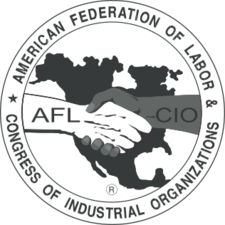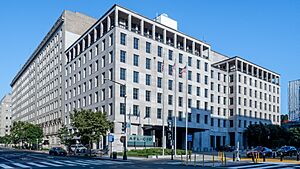AFL-CIO facts for kids
 |
|
| Formation | December 5, 1955 |
|---|---|
| Merger of |
|
| Type | Trade union center |
| Headquarters | Washington, D.C., US |
| Location |
|
|
Membership (2022)
|
12,471,480 |
|
President
|
Liz Shuler |
|
Secretary-treasurer
|
Fred Redmond |
| Secessions | Change to Win Federation |
| Affiliations | International Trade Union Confederation |
The American Federation of Labor and Congress of Industrial Organizations (AFL-CIO) is a very large group of worker unions in the United States. It is the biggest group of its kind in the country. The AFL-CIO includes 61 national and international unions. These unions together represent almost 15 million workers, both those currently working and those who have retired. The AFL-CIO works hard in politics to support policies that help workers and improve society.
The AFL-CIO was created in 1955. This happened when two big groups, the American Federation of Labor and the Congress of Industrial Organizations, joined together. Before this, they had been separate for a long time. In 1979, union membership in the U.S. was at its highest. At that time, the unions in the AFL-CIO had almost 20 million members. For 50 years, from 1955 to 2005, most union workers in the U.S. were part of the AFL-CIO.
In 2005, some large unions left the AFL-CIO. They formed a new group called the Change to Win Federation. However, some of those unions have since rejoined the AFL-CIO. Also, many local parts of Change to Win unions still work with local AFL-CIO groups. Today, some of the biggest unions in the AFL-CIO are the Service Employees International Union (SEIU), the American Federation of Teachers (AFT), the American Federation of State, County and Municipal Employees (AFSCME), and the United Food and Commercial Workers.
Contents
What is the AFL-CIO?
The AFL-CIO is a group of many different worker unions. It is like a team of teams. Each union is a member, but the AFL-CIO does not control everything they do. It only steps in for very specific reasons. For example, it might act if a member union is involved in corruption. It can also help solve disagreements between unions. As of January 2025, the AFL-CIO has 61 member unions. These unions represent almost 15 million workers.
How the AFL-CIO Works in Politics
The AFL-CIO has always been important in American politics. It was a big part of the "New Deal Coalition" that shaped politics until the mid-1960s. Even though it has fewer members now, it is still a major voice for workers. The AFL-CIO works to influence laws and policies. It also helps organize people at the local level. They raise money and support candidates who care about workers' rights.
In recent years, the AFL-CIO has focused on talking to lawmakers in Washington and state capitals. They also work hard to get people to vote in elections. For example, in the 2010 elections, they sent out millions of letters. These letters told members which candidates the union supported. They also had volunteers go door-to-door to talk to union voters.
How the AFL-CIO is Run
The members of the AFL-CIO are in charge. They meet every four years at a big convention. Each member union sends people called delegates to this meeting. The number of delegates depends on how many members the union has. Other groups connected to the AFL-CIO also send delegates. At the convention, delegates choose leaders and discuss important policies. They also decide how much money unions should pay to be part of the AFL-CIO.
Meetings and Locations
For many years, the AFL-CIO's leaders held their winter meeting in Bal Harbour, Florida. This meeting location sometimes caused problems. Later, the meeting was moved to Los Angeles to improve the organization's image. However, it was moved back to Bal Harbour after a few years. The 2012 meeting was held in Orlando, Florida.
State and Local Groups
The AFL-CIO has groups at the state and local levels. These are called state federations and central labor councils. Sometimes, the national unions pay the dues for their local groups. This makes it easier for the local groups. However, not all national unions pay these dues for their local parts.
Special Departments
The AFL-CIO has several special departments. One important one was the Industrial Union Department (IUD). This department was created to make sure that unions focused on organizing workers in whole industries. For a long time, the IUD helped unions grow. For example, it gave money to the American Federation of Teachers (AFT) in 1961. This money helped the AFT win an important election and become a much larger union.
There are six main departments in the AFL-CIO today:
- North America's Building Trades Unions
- Maritime Trades Department, AFL-CIO
- Metal Trades Department, AFL-CIO
- Department for Professional Employees, AFL-CIO
- Transportation Trades Department, AFL-CIO
- Union Label and Service Trades Department, AFL-CIO
Groups that Work with the AFL-CIO
The AFL-CIO also supports special groups called constituency groups. These groups help register voters and encourage people to vote. They also do research, hold training events, and work with other local organizations. These groups have a say in how the AFL-CIO is run.
The seven constituency groups include:
- A. Philip Randolph Institute
- AFL-CIO Union Veterans Council
- Asian Pacific American Labor Alliance
- Coalition of Black Trade Unionists
- Coalition of Labor Union Women
- Labor Council for Latin American Advancement
- Pride at Work
Other Organizations that are Allies
Many other organizations work closely with the AFL-CIO. For example, the Working for America Institute used to be a part of the AFL-CIO. It now works independently to promote economic growth and influence economic policies. The American Center for International Labor Solidarity also works to support free labor unions around the world.
Other allied organizations include:
- Alliance for Retired Americans
- Solidarity Center
- American Rights at Work
- International Labor Communications Association
- Jobs with Justice
- Labor Heritage Foundation
- Labor and Working-Class History Association
- National Day Laborer Organizing Network
- United Students Against Sweatshops
- Working America
- Working for America Institute
- Ohio Organizing Collaborative
Programs and Services
The AFL-CIO also has its own programs to help its members. These include investment trusts for housing and buildings. They also have the AFL-CIO Employees Federal Credit Union. The National Labor College is another program that helps educate union members. Union Privilege offers special benefits and services to union members.
International Work
The AFL-CIO is part of a global group called the International Trade Union Confederation. This group was formed in 2006. The AFL-CIO has always been active in helping to build strong, free unions in other countries. During the Cold War, it worked against Communist unions in places like Latin America and Europe.
In 2024, a cybersecurity company reported that hackers had tried to get information from the AFL-CIO's computer networks. These hackers were believed to be working for a foreign military group. They were trying to learn about trade negotiations.
History of the AFL-CIO
Working for Civil Rights
The AFL-CIO has a long history with the fight for civil rights. When the AFL and CIO were separate, the CIO was more open to including Black workers. The AFL had often focused on specific skilled trades, which sometimes excluded Black workers.
In 1961, Martin Luther King Jr. gave a famous speech to the AFL-CIO. He spoke about how civil rights and workers' rights were connected. He hoped that these two movements could work together to help all working people. However, King also pointed out that some unions in the AFL-CIO still excluded Black workers. He encouraged them to do more. King and the AFL-CIO later disagreed about the Vietnam War. The AFL-CIO supported the war, but King was against it. The AFL-CIO did support the Civil Rights Act of 1964, which helped end discrimination.
Police Unions and Protests
In recent years, the AFL-CIO has faced criticism because it includes the International Union of Police Associations (IUPA). In May 2020, during protests in Washington, DC, the AFL-CIO offices were set on fire. The protests were happening after the death of George Floyd. The AFL-CIO president at the time, Richard Trumka, spoke out against both the death of George Floyd and the damage to the offices. However, he did not say whether the AFL-CIO would end its connection with the police union.
Changes in Political Power
After a big election victory in 1964, many new laws were passed that helped people. These included the Civil Rights Act, the Voting Rights Act, and Medicare for older people. Union leaders felt they had helped make these changes happen. However, in the 1966 elections, many politicians supported by unions lost. This showed that union members sometimes had different ideas than their leaders. For example, some members were worried about taxes and crime.
The AFL-CIO also faced challenges in the 1970s. Their influence in politics began to change. For example, in 1972, they tried to stop a certain candidate from becoming the Democratic presidential nominee. But they were not successful. This showed that their power in politics was shifting.
Unions Leaving and Rejoining
In 2005, some of the largest unions left the AFL-CIO. These included the Service Employees International Union (SEIU), the International Brotherhood of Teamsters, and the United Food and Commercial Workers International Union (UFCW). They formed a new group called the Change to Win Federation. Other unions also left later.
However, some unions later rejoined the AFL-CIO. For example, a part of UNITE HERE rejoined in 2009. The Laborers' International Union of North America rejoined in 2010. The Service Employees International Union (SEIU) also rejoined the AFL-CIO in January 2025.
ILWU Leaves the AFL-CIO
In 2013, the International Longshore and Warehouse Union (ILWU) left the AFL-CIO. The ILWU said that members of other AFL-CIO unions were crossing their picket lines. They also felt the AFL-CIO was too willing to compromise on important issues like worker laws and healthcare. The longshoremen's union decided to become an independent union.
Leaders of the AFL-CIO
Presidents
- George Meany (1955–1979)
- Lane Kirkland (1979–1995)
- Thomas R. Donahue (1995)
- John J. Sweeney (1995–2009)
- Richard Trumka (2009–2021)
- Liz Shuler (2021–present)
Secretary-Treasurers
- 1955: William F. Schnitzler
- 1969: Lane Kirkland
- 1979: Thomas R. Donahue
- 1995: Barbara Easterling
- 1995: Richard Trumka
- 2009: Liz Shuler
- 2021: Fred Redmond
Executive Vice Presidents
- 1995–2007: Linda Chavez-Thompson
- 2007–2013: Arlene Holt Baker
- 2013–2022: Tefere Gebre
See also
 In Spanish: AFL-CIO para niños
In Spanish: AFL-CIO para niños
- Labor history of the United States
- Labor unions in the United States
- List of labor unions in the United States


